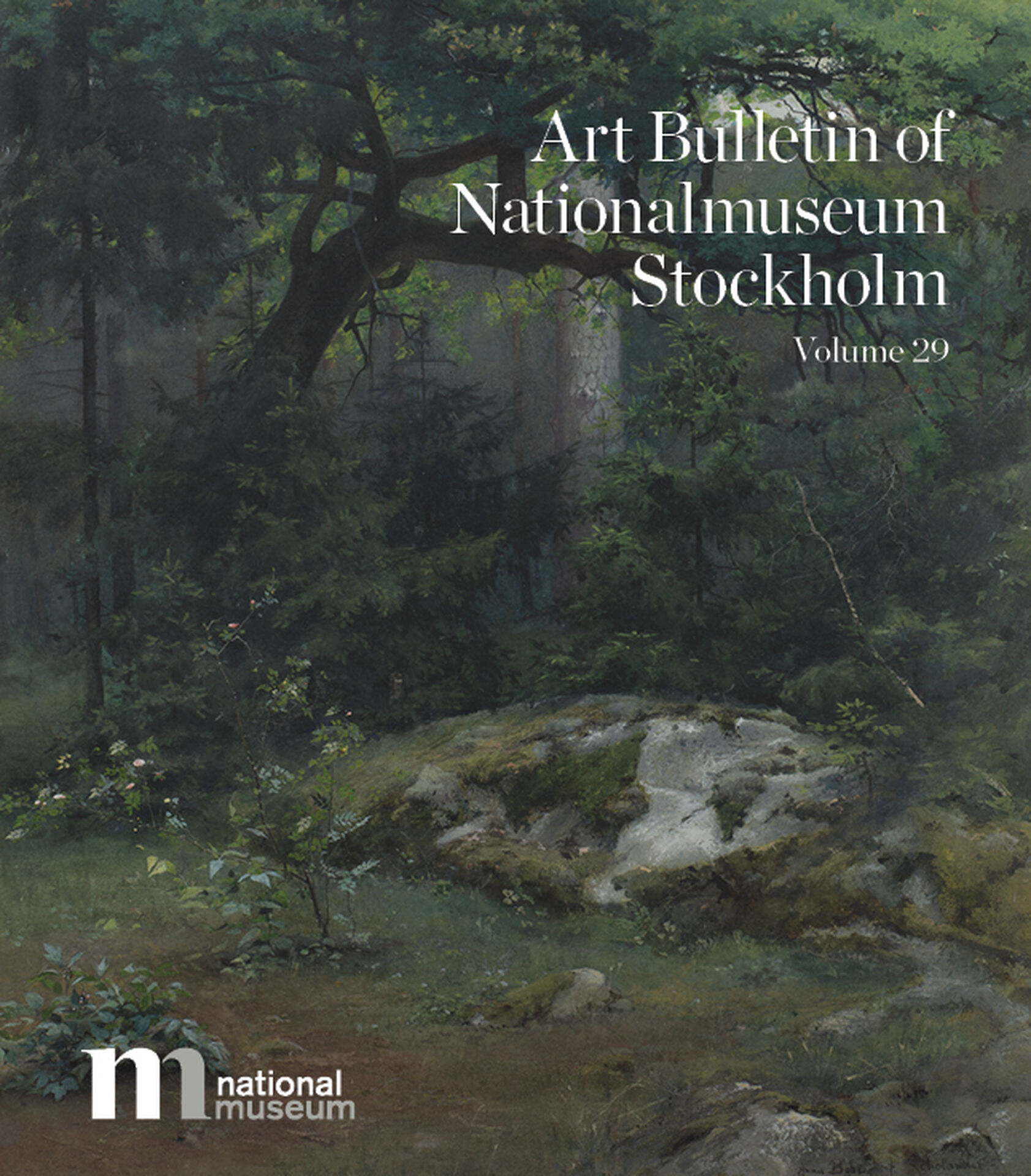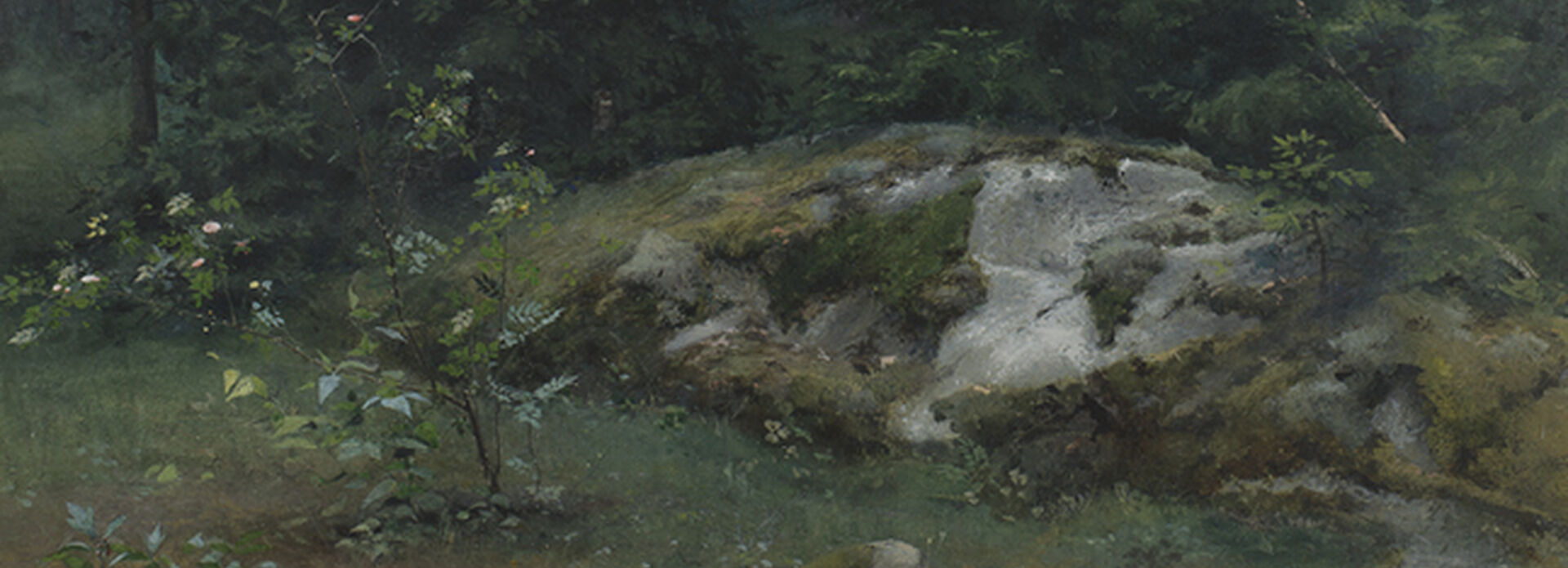The Art Bulletin of Nationalmuseum Stockholm is a journal devoted to art history. It is published in English with a content that ranges from older master paintings to contemporary design. This, volume 29, includes articles on acquisitions in 2022 as well as several articles in art history on works in the museum's collections.

Anna Boberg, The Clearing in the Woods, NMB 2801. Cover of volume 29.
The Art Bulletin is published through DiVA (a publishing system for research publications and student essays and a digital archive for long-term preservation of publications). You can also reach it via the links below. You can open, or download the publication in its entirety, or the articles separately.
Download Art Bulletin Volume 29, high resolution pdf
Download Art Bulletin Volume 29, low resolution pdf
Articles
Foreword
Patrick Amsellem
Acquisitions
The Silverhielm Service
Micael Ernstell
The Silfverhielm Service is an exclusive dessert service from the 1790s, donated to the Nationalmuseum by Maria and Magnus Silfverhielm. It consists of 29 pieces with blue and gold decoration and the family coat of arms. The service reflects the luxury of the time and was used to serve exclusive desserts such as ice cream. Although family tradition claims it was made in Meissen, stylistic features suggest English origins, possibly from Derby Porcelain.
From and his Church Ruin
Jesper Svenningsen
The painting Inside the Marble Church, Copenhagen (1836) by H.C. From exemplifies key themes of Danish Golden Age art, particularly the intersection of plein-air
sensibilities and architectural precision. This article examines the painting’s historical context, its role in From’s artistic debut, and its significance within 1830s Danish landscape painting. Emphasis is placed on From’s architectural focus, his transition from shipbuilding to art, and his underrecognized contributions to the period’s visual culture.
In the Forest of Fontainebleau – a Historical Light on Contemporary Acquisitions
Magnus Olausson
The Nationalmuseum’s recent acquisitions of works from the Forest of Fontainebleau highlight a pivotal development in art history, tracing the evolution from early plein air studies to the mature realism of the Barbizon School. Through paintings and studies by artists such as Jean-Victor Bertin, Jules Coignet, Jean-Baptiste-Camille Corot, Théodore Rousseau, and Narcisse Virgile Diaz de la Peña, the forest emerges as an artistic laboratory where the forms, light, and atmosphere of nature were explored with great sensitivity. These works reflect not only a shift in landscape painting’s technique and aesthetics but also a transformed perception of nature as a subject. The study situates these artistic expressions within the broader context of 19th-century intellectual currents, technical innovations such as photography, and the emergence of a new artistic identity that foreshadows Impressionism.
Academy Studies by Elsa Beskow (née Maartman) and Natanael Beskow
Martin Olin
The Nationalmuseum’s acquisition of drawings by Elsa Maartman (later Beskow) and Natanael Beskow sheds light on the practices of art education at the Technical School and the Royal Academy of Fine Arts in the 1890s. The material includes figure and antique studies, often technically refined and countersigned by professors such as Gustaf Cederström and Georg von Rosen. Elsa Beskow’s training at the Technical School provided her with a solid foundation as an illustrator, while Natanael Beskow’s drawings reflect a more traditional academic discipline. The acquisition not only documents two artistic trajectories but also illustrates contemporary views on artistic rigor, gender roles, and the role of education in artistic development.
Isaac Grünewald’s Self-Portrait from 1915
Andrea Kollnitz
Nationalmuseum has recently acquired one of Isaac Grünewald’s most transgressive self-portraits where he stages himself in a highly stylised and theatrical fashion. While promoting himself as a true avant-garde painter, in this colourful and expressive painting he also plays with conventions and conceptions of gender and identity at large.
Abstract Lisa Larson Sculpture, Inspired by her 1966 Sabbatical at UC Berkeley
Ulrika Schaeder
This article explores a pivotal yet lesser-known chapter in the career of Swedish ceramicist Lisa Larson (1931–2024), focusing on her sabbatical year in the United States (1966–1967), particularly her time at UC Berkeley under the influence of Peter Voulkos and the California Clay Movement. The experience marked a creative turning point, prompting Larson to explore abstraction and sculptural expression beyond functional ceramics. Her exposure to American studio ceramics, folk art, and countercultural ideals significantly shaped her artistic language. The Nationalmuseum’s acquisition of a sculpture from this period enriches the understanding of Larson’s oeuvre and highlights the transatlantic exchange that influenced Nordic design in the mid-20th century. The article also traces the long-term impact of this journey, culminating in Larson’s late-career monumental work in Japan, thus completing a cross-cultural ceramic dialogue spanning decades.
The Challenge of Sustainable Fashion
Cilla Robach
An analysis of the fashion industry's environmental impact reveals that it contributes nearly 10% of global greenhouse gas emissions, even as clothing production has doubled since the early 2000s. In response, H&M has launched several sustainability initiatives, notably the Innovation Stories project and the Circular Design collection. These efforts include recycling programs, rental services, and the development of recyclable materials and technologies. The Circular Design collection merges high fashion with environmental innovation, featuring multifunctional garments and design solutions that support recycling. At the same time, questions are raised about whether party wear is the most effective medium for promoting sustainable fashion.
Art history
Rediscovering the Golden Books: The Illuminated Manuscripts Project
Christian Etheridge
Extensive research and conservation efforts were undertaken during 2022–2023 as part of the Illuminated Manuscripts Project. Supported by an anonymous donation, the initiative focused on analyzing, conserving, digitizing, and revitalizing the museum’s collection of Medieval and Renaissance manuscripts – an internationally significant yet long-overlooked part of the holdings. The collection includes 58 richly illuminated manuscripts and fragments dating from around 1050 to 1530, encompassing Christian, Jewish, Islamic, and secular texts. The project led to new identifications, enhanced accessibility through digital cataloguing, and laid the groundwork for future research. In 2024, a new three-year project on manuscript cuttings, funded by the Berit Wallenberg Foundation, was launched.
The Sharpest Hunters of the Skies: Late 16th-Century Hunting Bird “Portraits” for the Wittelsbach Court
Carina Fryklund
A unique series of late 16th-century hunting bird portraits in the Nationalmuseum offers insight into the Wittelsbach court’s fascination with falconry, natural history, and artistic patronage. These large-format watercolours on vellum, attributed primarily to Hans Donauer the Elder and Hans Hoffmann, depict hawks and falcons with striking naturalism and precision. Commissioned during the reigns of Dukes Albert V and William V of Bavaria, the works reflect the era’s blend of scientific curiosity and aristocratic spectacle. The birds, often shown with jesses and hoods, were likely part of the court’s aviary at Trausnitz Castle and served both as zoological documentation and symbols of noble identity. The paintings also connect to broader European traditions of falconry and early ornithological illustration, influenced by figures like Joris Hoefnagel and Conrad Gessner.
A Memory from Poland
Emilia Ström
Two 17th-century portraits here attributed to the Polish artist Daniel Schultz – traditionally identified as Nils Posse the Younger and his wife Anna Stake – are reexamined through stylistic and technical analysis. These investigations cast doubt on the established identities, particularly since the female portrait appears to have been painted around 1675, a date inconsistent with Anna Stake’s known lifespan. The study also considers the portraits’ potential origins in Poland and their arrival in Sweden, possibly as spoils of war during the Great Northern War. In doing so, it sheds light on both the complexities of artistic attribution and the broader cultural exchanges between Poland and Sweden in the early modern period.
Drawings by Claude Gillot in the Nationalmuseum, Old and New
Axel Moulinier
This article reattributes 45 drawings in the Nationalmuseum to Claude Gillot (1673–1722), highlighting his collaboration with Claude III Audran in early 18th-century France. The drawings – ranging from ceiling and wall decorations to furniture and theatrical designs – demonstrate Gillot’s inventive style and central role in Audran’s workshop. The study sheds new light on Gillot’s artistic legacy and the transmission of his designs within decorative arts circles.
A Rubens’ Wife Portrait Miniature by John Cox Dillman Engleheart
Magdalena Hammar
An 1815 portrait miniature by John Cox Dillman Engleheart depicts an unknown woman dressed in the style associated with Helena Fourment, the second wife of Peter Paul Rubens. Although the sitter’s identity remains unknown, the work stands out as a rare example in a Swedish collection of the “Rubens’ wife” portrait type, which gained popularity in 18th-century English portraiture. This style, inspired by a misattributed Van Dyck portrait of Fourment, became a fashionable way for women – particularly from the gentry and upper middle class – to express ideals of beauty, virtue, and cultural sophistication. The study traces the origins of this portrait type, its spread through artists and drapery painters such as Joseph van Aken, and its symbolic role in shaping female identity and social aspiration.
Artists and the French Luxury Industry of the Early 19th Century
Magnus Olausson
During the Napoleonic era and the Restoration, French luxury porcelain became a powerful symbol of national prestige, driven by imperial patronage from figures like Napoleon I and Empress Josephine. Leading manufacturers such as Sèvres, Dihl et Guérhard, Dagoty, and Darte et frères collaborated with renowned artists – including Jean-Baptiste Mallet, Jean-Louis Demarne, and Marie-Victoire Jaquotot – who provided original designs and painted reproductions of famous artworks. Porcelain objects like portrait cups and dessert services served diplomatic, commemorative, and propagandistic purposes. Women artists played a key role, especially Jaquotot, who rose to prominence as Premier peintre du Roi. Her work exemplifies the fusion of fine and decorative arts in early 19th-century France, reflecting both artistic excellence and political ambition.
Walter Crane´s Illustrations for A Wonder-Book for Girls and Boys in the Nationalmuseum. Early British Influence on Elsa Beskow, John Bauer and Gustaf Tenggren and the Enduring Influence of Their Work on Narrative Art. Walter Crane’s illustrations for A Wonder-Book for Girls and Boys (1892) exemplify the Arts and Crafts movement’s ideals of integrating text and image. Acquired by the Nationalmuseum in 1896, these works influenced Swedish illustrators such as Elsa Beskow, John Bauer, and Gustaf Tenggren. The article traces this British-Swedish artistic lineage and its lasting impact on narrative art, from early children’s books to 20th-century animation and fantasy illustration.
The Tessin Lecture
In the Pink: Old Ladies, Young Men and Racial Whiteness in French Portraiture of the 18th-Century
Melissa Hyde
Though never as ubiquitous in the 18th century as the color blue, pink became the color par excellence of the French Rococo. The color was intimately associated with the so-called ‘Godmother of the Rococo’, Madame de Pompadour, the famous mistress of Louis XV. But pink was also a hue favored generally amongst elites in France, where it attained an unprecedented level of visibility in the visual and decorative arts and in the fashions worn by women, children and men. To wear pink or to have one’s portrait made wearing it, was to make a statement – especially when the wearer was a woman of a “certain age.” This article demonstrates ways in which gender, age, class and race could contribute to the cultural meanings of 18th-century portraiture “in the pink”.
The Friends of The Nationalmuseum
The Friends of the Nationalmuseum. The Year in Review 2022
Niclas Forsman
Acquisitions 2022
See all the previous volumes of Art Bulletin.
Editorial staff
Editors: Ludvig Florén and Martin Olin.
Editorial Committee: Eva-Lena Bergström, Ludvig Florén, Helena Kåberg, Martin Olin and Cilla Robach.
The publication has been funded by the Friends of the Nationalmuseum.
E-ISSN: 2001-9238
The abstracts above are partly created with Copilot and reviewed by the Editorial Committee.
